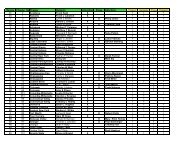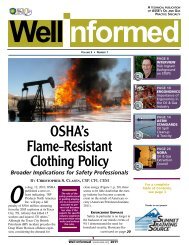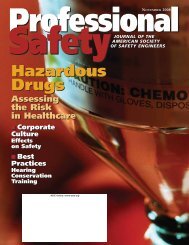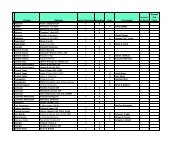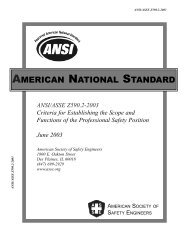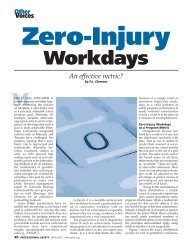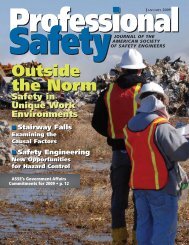Safety & Health Effects of Shift Work - ASSE Members
Safety & Health Effects of Shift Work - ASSE Members
Safety & Health Effects of Shift Work - ASSE Members
You also want an ePaper? Increase the reach of your titles
YUMPU automatically turns print PDFs into web optimized ePapers that Google loves.
Photo 3: Sellstrom production team.<br />
Some new products are born from<br />
problems that occur with some <strong>of</strong> the<br />
newer manufacturing or process<br />
techniques.<br />
Sellstrom works with customers<br />
independently to develop new specialized<br />
products through research<br />
studies and material advancements.<br />
These can be as simple as a change<br />
request in anti-fog properties or as<br />
advanced as new field requirements<br />
due to technological advancements,<br />
(i.e., firefighting, autoclaving,<br />
gamma radiation, etc.).<br />
MPS: Has Sellstrom ever needed<br />
to create eye or face protection to<br />
protect against injuries that were<br />
previously nonexistent or once rare<br />
in the workplace<br />
DP: Probably not create; however,<br />
we have tweaked a few existing<br />
products to fulfill a unique requirement<br />
for a special situation.<br />
MPS: How does Sellstrom test its<br />
products to ensure proper fit and<br />
level <strong>of</strong> protection<br />
DP: We follow the requirements<br />
<strong>of</strong> most <strong>of</strong> the existing standards for<br />
eyewear throughout the world. We<br />
have our own lab on premises and<br />
have all <strong>of</strong> the equipment “certified<br />
for accuracy” at prescribed intervals.<br />
We are an ISO 9001:2008-certified<br />
company. We are constantly refining<br />
all <strong>of</strong> our systems and processes that<br />
go into making our testing and quality<br />
system credible.<br />
MPS: What are the components <strong>of</strong><br />
Sellstrom’s quality management<br />
system<br />
DP: The quality management<br />
system consists <strong>of</strong> processes that<br />
pursue customer satisfaction with the<br />
underlying goal <strong>of</strong> quality improvement<br />
in all phases <strong>of</strong> our operation—<br />
marketing/sales, research/design,<br />
purchasing, manufacturing, quality<br />
control and logistics <strong>of</strong> products.<br />
MPS: How does Sellstrom ensure<br />
that it continually meets or maintains<br />
the requirements <strong>of</strong> ISO<br />
9001:2008 certification<br />
DP: We are audited by an ISOcertifying<br />
body twice a year. The<br />
requirements to maintain this certificate<br />
are defined and must be demonstrated<br />
to our auditor at any time.<br />
We do our own internal audits and<br />
issue recommendations to each<br />
department to ensure that we perform<br />
to a prescribed level. The new<br />
standard demands continuous improvement<br />
as well as measuring a<br />
degree <strong>of</strong> customer satisfaction<br />
with our entire process. Continuous<br />
training <strong>of</strong> our personnel and empowering<br />
them to build products<br />
conforming to applicable standards<br />
<strong>of</strong> performance are critical to our<br />
quality program’s success. <br />
David Peters is CEO and president <strong>of</strong><br />
Sellstrom Manufacturing Co., Palatine, IL.<br />
Peters holds a marketing degree from<br />
Northern Illinois University.<br />
<strong>Safety</strong> & <strong>Health</strong> <strong>Effects</strong> <strong>of</strong> <strong>Shift</strong> <strong>Work</strong><br />
continued from page 1<br />
working shift work schedules impact the health <strong>of</strong> workers<br />
and the frequency <strong>of</strong> accidents, and how do the<br />
impacts differ for older workers and for women<br />
A common thread for all employees is the toll that<br />
shift work takes on them mentally and physically, leading<br />
to increased potentials for illnesses and for occupational<br />
injuries. According to Bird and Mirtorabi (2006),<br />
shift work contributes to the world’s worst industrial<br />
accidents and costs employers $206 billion annually,<br />
including more than $70 million for shift work-related<br />
accidents and $15.9 billion for medical treatment.<br />
Negative health effects for shift workers include<br />
increased incidence <strong>of</strong> cardiovascular and gastrointestinal<br />
illnesses, obesity, cancer and diabetes. Additionally,<br />
circadian rhythm adjustment and fatigue associated with<br />
shift work are reported to increase the accident and<br />
injury frequencies, both on night shifts and on day shifts.<br />
Many <strong>of</strong> the adverse health and safety effects can be<br />
tied back to employee’s sleep and waking schedules being<br />
unsynchronized with their natural circadian rhythms, causing<br />
immediate and acute fatigue. Fatigue causes slower<br />
reaction times and loss <strong>of</strong> mental acuity and may contribute<br />
to hypertension, diabetes and other ailments. With<br />
shift work an established element <strong>of</strong> modern work life, it<br />
is necessary for employers to look at ways that the effects<br />
can be mitigated. This may include adjusting the duration<br />
and direction <strong>of</strong> rotating shifts, the length <strong>of</strong> work shifts<br />
and the number <strong>of</strong> breaks incorporated, the balance <strong>of</strong><br />
scheduled work shifts and time <strong>of</strong>f and even work scheduling<br />
and illumination. Making an effort to minimize the<br />
adverse impacts <strong>of</strong> shift work may be seen as providing a<br />
safe place to work under the OSHA general duty clause.<br />
Additionally, Dembe (2009) predicts that “it would not be<br />
surprising to see an increasing number <strong>of</strong> claims for workers’<br />
compensation benefits for cardiovascular diseases,<br />
cancer and other ailments that have been associated with<br />
long working hours.”<br />
HEALTH EFFECTS OF SHIFT WORK<br />
According to Roan (2008), “As much as 15% <strong>of</strong><br />
human genes function on a schedule, with highly regulated,<br />
oscillating patterns <strong>of</strong> activity. These clocklike<br />
genes are common features <strong>of</strong> most cells and can be<br />
found in every major organ in the body. They, in turn,<br />
affect the schedule <strong>of</strong> scores <strong>of</strong> biological functions,<br />
from metabolism to cell division to cognitive processes.”<br />
These oscillating patterns are known as circadian<br />
10<br />
Safely Made www.asse.org 2011




